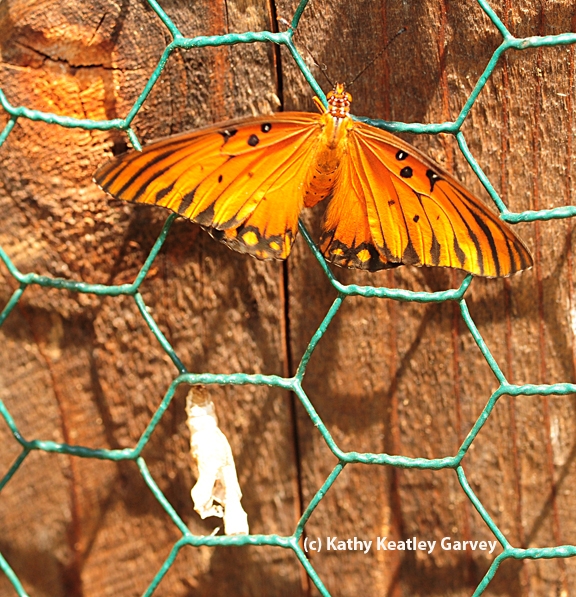At last! From an egg to a caterpillar to a chrysalis to a butterfly.
And it's a girl!
For several days we've been protecting a Gulf Fritillary (Agraulis vanillae) chryalis on our passionflower vine (Passiflora) from predators.
It works like this: Adult female butterflies lay their eggs on the plant, and predators prey upon the eggs, caterpillars and chrysalides. Result: eggs gone, caterpillars gone, and chrysalides smashed open and the contents (our future butterflies) removed.
So we clipped a white cotton dishtowel around the chrysalis to prevent predation from jumping spiders, orb weavers, ants, praying mantids, European paper wasps and assorted scrub jays.
Sunday morning it happened.
A female butterfly emerged from a chrysalis. She remained close to the chrysalis before moving outside the apiary wire (the wire is stapled to a fence to support the clingy passionflower vine).
Not two minutes later, as "our girl" was drying her wings, getting ready for her first flight, a suitor approached her.
The rest, as they say, is history.
And more Gulf Fritillary butterflies.
We hope.
Attached Images:

Female Gulf Fritillary butterfly dries her wings after emerging from her chrysalis. (Photo by Kathy Keatley Garvey)

Newly emerged Gulf Fritillary butterfly hangs on the fence. (Photo by Kathy Keatley Garvey)

A suitor approaches the female. (Photo by Kathy Keatley Garvey)

Almost engaged. (Photo by Kathy Keatley Garvey)

Mating Gulf Fritillary butterflies. (Photo by Kathy Keatley Garvey)

The female is doing a post-coital stretch, according to butterfly expert Art Shapiro, professor of evolution and ecology at UC Davis. "She's a tad oddly marked, too." (Photo by Kathy Keatley Garvey)